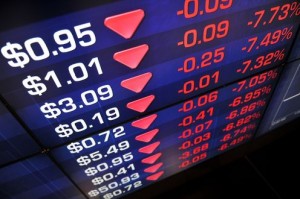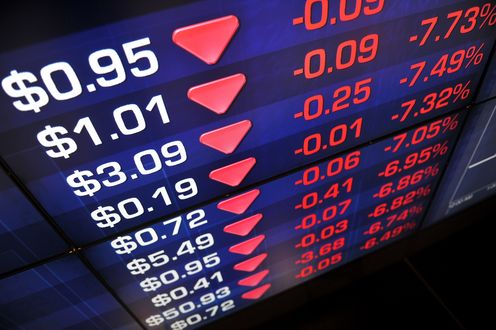 About 32 percent of all stock trades in the US stock markets are being done “off market” in “dark pools” and other confidential “trading platforms”. Trading on well-known markets such as the New York Stock Exchange and NASDAQ has been dropping precipitously.
About 32 percent of all stock trades in the US stock markets are being done “off market” in “dark pools” and other confidential “trading platforms”. Trading on well-known markets such as the New York Stock Exchange and NASDAQ has been dropping precipitously.
The “dark pools” have taken over some increasing chunks of the market shares that used to go to these and other major exchanges. Also, as the article from Business Week points out, massive amounts of money have fled the normal stock and other equity markets due to a lack of confidence and trust in those markets.
This video from the Wall Street Jounal explains what “dark pools” are. Most people are likely very much in the dark about them.
To put it simply, “dark pools” are pools of liquidity and financial capital that are flowing from one trader to another. One customer of a broker might need to move a large amount of a certain security, stock, derivative, bond or bill without it being noticed on the public markets. “Dark pools” are confidential, secret and certainly not registered with the SEC or on any public notice boards of the trades.
If the large trade were to flow into the data banks of the algorithms of the high frequency traders — who really run the market to a very big extent — then the price of the security the trader wants to move can drop rather quickly. So, it is thought by these surreptitious security traders that one can retain more value by keeping the trades secret. “Dark pools” have been developing in China, the EU, and even in places like Indonesia, the Philippines, and all across the world.
Increasing development of the dozens of confidential platforms is in part a response to the development of high speed trading. High speed trading has a huge influence on the stock markets in the US and in many other countries. As the risks to trading have increased with the faster diffusion into the marketplace of high speed trading, so too have the “dark pools” and other surreptitious trading platforms developed.
There have been many instances of obvious mispricing of securities by some of these black box algorithms, such as sending the price of many well capitalized companies heading towards penny stocks in the matter of seconds during “flash crashes”, as happened in May 2010. One of the biggest energy companies in the world, Exelon, was deemed almost worthless on the markets for a moment. Proctor and Gamble became a penny stock.
One of the main reasons behind this flash crash was the high frequency trading companies’ algorithms (hyper complex mathematical stock and derivative trading models) kicking in to react to an order to sell 75,000 E-Mini Standard & Poor’s 500 futures contracts. If this seems somewhat to very obscure to you do not get worried that you are out of the loop on what is really going on in the stock, futures and derivatives markets. My guess is 99 percent of the people in the US, if not the world, are pretty much clueless about what is happening and who is doing what.
It is not just the existence of “dark pools” or of high speed trading that lends to huge potential volatility — even worse is the combination of the two. There is an increasing opacity to securities markets while at the same time an increasing dominance of very complex, black box mathematical algorithms that trade at velocities that are beyond the comprehension of just about everyone, including some of the people who are at the top of these trading companies.
One of my biggest concerns about high frequency trading is that the models, the algorithms used for trades, may not be built to handle major commodity price shocks, such as what may occur with an invasion of Iran and the response and counter-response that may happen after that.
One only has to consider the 1998 collapse of Long Term Capital Management (LTCM) that was sparked by the combination of the East Asian Financial Crises in 1997-1998, the default of Russia and the collapse of the ruble, as well as other complex factors, to see how this may happen again.
Please note LTCM was established by a bunch of Nobel Laureates and had some of the best and brightest “rocket scientists” of algorithm development on their staff. This article from CATO also discusses the government sponsored and constructed bailout of LTCM. Sound familiar? This was in 1998.
I find the potential robustness of these models in times of even moderate stress to be suspect.
We can now add in the problems that could result from the “dark pools” to the “high frequency trading” to those of the shadow banks that I mentioned in a previous article.
Indeed, the risks to the toppling of asset values and economies via oil and other commodity shocks are looming if there are any serious military shocks, most particularly if significant oil facilities such as Ab Qaiq are seriously damaged in the medium to long runs.
It is not just an attack of Iran that would shock the markets, but what follows after that. Iran is unlikely to back down and cower. It will counter attack. The Iranians have stated this quite clearly.
The effects of these shocks could also be magnified due to the fragility of the global economy. That volatility can be further magnified by the fall of the assets that back the shadow banking systems of securities and derivatives. This could be made even worse via high frequency trading and the increasing opacity of markets via “dark pools”.
One might expect large investors to initially flock to the “dark pools” to dump their securities. This may be kept quiet for a short while. However, sooner rather than later, the expected huge movements of assets that will be attempted to be dumped to preserve value will be noticed and talked about. Then the high frequency trades kick in full force. Add to this the fall in assets backing up the hundreds of trillions of dollars in derivatives and you have quite a problem.
Can you imagine the “flash crash” developing into a “smash crash” from a spreading conflict in the Gulf?
I really wonder how those black box computer programs would respond when the price of oil goes beyond the outer boundaries of their assumptions – and stays there.
Many markets have become too fast, too incomprehensible, and too opaque for the average investor and even for most governments. Some of these markets may be heading toward a dangerous tipping point on some issues not far in the future anyway.
A war in an area with 70 percent of all known commercially available conventional oil reserves and all of the excess oil capacity in the world may help that tipping point to arrive faster and in a more furious way.
Very few know what is really happening in the “dark pools”. Very few know what is really happening inside those black box algorithms of the high frequency traders. Shadow banking remains in the shadows.
Policy recommendation: governments and others need to look more into these dark regions to fully analyze certain strategic economic, political and other decisions. The world economy has changed vastly even in the last few years with massive liquidity traps and small reactions to monetary and fiscal policy than in the past and the existence of many great unknowns that contain massive amounts of assets within them. These policy responses need to be global as well as national given the massive international flows of money each day, often in the trillions of dollars if one also adds in foreign exchange transactions.
This odd amalgam of the old and new financial systems may be resilient to normal shocks and small shocks, but big shocks could make things rather bad indeed.
Governments and others need to understand and navigate in the dark corners of finance — and there are many of them — in order to understand what might happen next.






Very interesting and important topic. Why our nations defense organizations are only starting to look at this now is shocking. Our enemies have long been aware.This same issue has been mentioned in a DoD report that is dicussed in the April issue of American Legion Magizine. http://www.legion.org/magazine/162503/message-no-one-wanted-hear
Kevin Freeman has also written a best selling book on the topic of Economis Warfare. “Secret Weapon”.
You do realize that “Dark Pools” are a way of slowing down trading, right? Place your order in liquidnet, if someone matches it, it will cross at some random time every five-minute-ish.
More importantly, you do realize that there are no dark pools in the futures/energy markets, right? The futures markets slow down their trading by using locals, who take a bigger chunk than dark pools would. Most of the bad press for this sort of thing actually comes from block shopping locals and large houses, who are being made irrelevant by technology.
“My guess is 99 percent of the people in the US, if not the world, are pretty much clueless about what is happening and who is doing what.”
Yeah, but most of them have the decency to not make misinformed commentary on the subject.